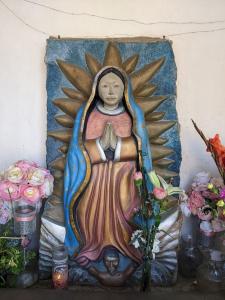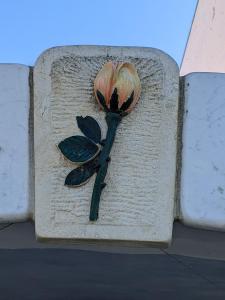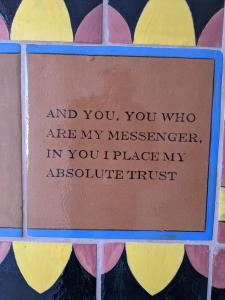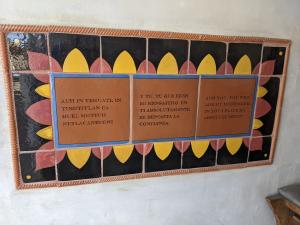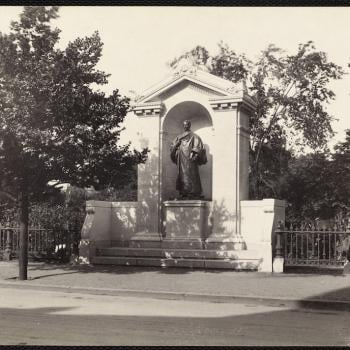The list of things I do not believe in is quite long.
Among the things I do believe is our Lady of Guadalupe.
Okay, believe isn’t quite the right word.
Rather Mary appears in my life in all sorts of intersections. She does have different names at these intersections. And her face looks different. But only if I don’t look deep,
But when I do, there she is. Sometimes not so obviously. Sometimes without any possible confusion.
For instance, it was a delight when Jan and I paused in the tiny town of Guadalupe on our drive up to Morro Bay. Walking on Guadalupe street we stumbled upon a small street shrine dedicated to her.
It set my imagination riot.
Guadalupe is a town of history, which means a town of sadnesses as well as joys. Since the missions arrived in 1787 the area has mostly been about agriculture. The fertile land has been a gathering place for many different peoples, starting with Chumash, and then the Spanish, and the evolving Mexican cultures, other Europeans, Filipinos, Chinese, and Japanese.
The town was formed in 1840.
Japanese workers settled in the Santa Maria Valley to work in the sugar beet fields before the turn into the 20th century. In 1909 the Reverend Jundo Izumida, a Jodo Shinshu minister rented space in town to hold services. They flourished. Until 1941. At first the property was protected by white friends, but after they were driven from the town, the building fell into disrepair. The good news in this particular story is that by 1950 the congregation had regathered and actually continues to flourish. When they encounter her she has a different face and a different name. But she’s definitely among them.
Our Lady is particularly concerned with workers and the poor. Today we see her often among those who remained after the American conquest, and those who immigrated later. They give us this name for her, Our Lady of Guadalupe.
Almost certainly the shrine we found was built by them. It’s an informal affair, I suspect. Although beautiful and cared for. I googled around, but couldn’t find anything about the shrine. Possibly it is connected to the local Roman church which is dedicated in her name. But. And.
As the story tells us.
On the 15th of December (or by the Julian calendar on the 9th) in 1531 the Virgin of Guadalupe first appeared to the indigenous peasant Juan Diego Cuauhtlatoatzin. As proof for the archbishop Juan Diego was instructed by Our Lady to gather up flowers, he found roses not native to the area, wrapped them in his tilma, and when he opened his cloak before the bishop, the roses fell to the ground and her image was revealed on the inside of the tilma.
The documentation for the encounters are scant. Of these encounters there are said to have been five, four to Juan Diego and once to his uncle. As is the historicity of Juan Diego. For those who care. And usually in these matters, I do, the principal source is the Nican Mopohua, a 17th century account written in the Nahuatl language. Did I mention our Lady spoke to Juan Diego in Nahuatl?
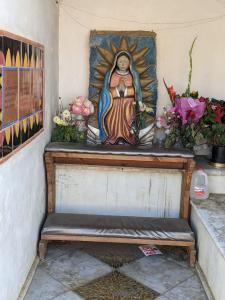 She is a vital image of the mother of the universe.
She is a vital image of the mother of the universe.
If God’s grace were to be revealed, to whom would that be? Certainly not presidents or potentates, popes or televangelists. Rather the divine would, if God really were good, come first to those who work the fields, to day laborers, to beggars, to prostitutes, to the lost, and to the forgotten. And she speaks to them in the languages of the oppressed. Always.
I’ve seen her in both the worst moments, and the best.
She is the icon of hope for the hopeless, and the grace which manifests like a small plant appearing in a crack in the sidewalk.
I gaze on her face in that little street shrine in Guadalupe, California, and my heart feels the call of hidden truths.
And I am grateful…


